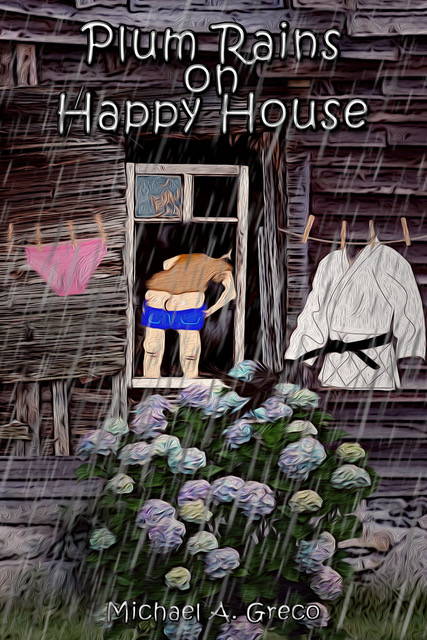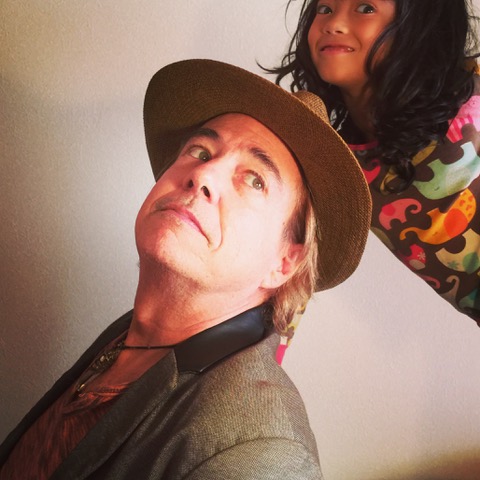A Writers in Kyoto Interview with Michael Greco.
- Could you tell us
briefly about how you came to Kyoto?
I’m the only person I know who actually came to Japan by boat, landing in 1983 after living several months in Russia, then the Soviet Union. My major at UC Irvine, near Los Angeles, was Russian, and after graduation I joined a student tour group, living several weeks in different Russian cities, and gradually traveling eastward on the Trans-Siberian Railroad. Another American in the group, who was far more organized than myself, had an edition of Lonely Planet that I began to browse, and I remember my jaw dropping upon reading I could make all of forty dollars an hour teaching English in Japan! Wow! Before learning this, my plan was to see Tokyo, then visit Australia, before returning home.
As the ship sat in Yokohama harbor waiting for processing, I asked a Japanese gentleman where Tokyo was, and he simply waved his hand at the enormous brown smudge in the distance. I remember thinking, ‘Oh, so it’s a lot like Los Angeles.’
But the smudge seduced me that first night. I was transfixed by the non-stop, electrifying neon of the early 80s. After all, I’d just spent five months in sleepy Russia, where the entertainment consisted of making friends, drinking, dancing and complaining of the food. I knew I would stay that first night in Shinbashi. The earthquake and subsequent catastrophes of 2011 prompted my family (we had a two-year-old at the time) to leave Tokyo and return to Los Angeles.
But Japan is in the blood. We came back in 2013, this time to Kyoto.
- How and when did you
take up writing?
I started writing in my later years. I wasn’t ready when younger, wandering with story ideas that were only half-baked, unable to express myself through prose in any real way. I write now because I can’t not write. Just ask my family: If I’m not plugging away at something, I’m not much fun to be around.
I write for myself, not for the market. I have no idea what will sell, but as long as I’m happy with a story, I will show it. I don’t know if I’m going to make any money doing this, but I don’t write to get rich. I do it for another, deeper satisfaction. I also write for the person I know best: myself.
I’ve settled on comic fantasy as a literary genre. Humor with thoughtful undertones. Visionary. Metaphysical. Childish. But I’m not for children. I write about teens, but not necessarily for them. My sub-genre might be: weird fiction. But Amazon has yet to make a category for that.
- Your novel Plum Rains on
Happy House is set in a transmogrified Kyoto with a touch of the grotesque. How
did you conceive of the idea?
“Plum Rains on Happy House” is a result of personal experiences of living in Tokyo and not having any money. If you’re broke, you often live in a guest house (or gaijin house). I’ve lived in a few, though none were as interesting as the one in Kawasaki, which is the model for “Happy House”. I lived there, thinking the whole time: ‘Somebody has got to write a story about this craziness!’

The novel is really a detective story. A fellow named Harry invites the protagonist, nicknamed the Ichiban, to Japan. But the residents of Happy House all deny any knowledge of this mysterious Harry. Readers may pick up on the references to the 1973 film The Wicker Man, about a policeman who is lured to a Scottish island to investigate the report of a missing child. It’s a game of deception. The islanders are playing with him. The paganism and the sexual activity the sanctimonious policeman finds so objectionable are simply part of the selection process—to see if he possesses the characteristics to burn in their wicker effigy so that the village will have subsequent successful harvests. In “Plum Rains on Happy House”, the Ichiban must undergo his own horrific sacrifice to appease the house. The novel is a tribute to that remarkable film, and it has the same basic plot lines, but I’ve laid down hearty layers of satire and side stories.
In creating the residents of Happy House, I mingled the characteristics of a few of the unique people I’ve met over the decades in Tokyo and in Los Angeles. In some cases, I didn’t need to exaggerate at all. The residents of the house had to be distinctively quirky, and I didn’t know how bawdy things were going to become, or how much depravity would creep its way into the story. But once I had the characters, they took charge and I relegated myself to being, more or less, their stenographer.
I’ve mixed in a lot of elliptical dialogue I feel compliments the baffling idiosyncrasies of Japan that newcomers have a hard time handling. I’ve also structured the story within the sometimes vexing stages of culture shock, which frame the Ichiban’s misadventures, and eventual acceptance, of the house—which has its own plans. After all, the old guesthouse is haunted:
“Happy House is an amoeba everlasting, a floating world—capturing and sealing the self-indulgence of the red-light districts, the bordellos and the fleeting, delightful vulgarity of ancient Japan, an eternal time capsule of the flamboyant and the boorish.”
The dichotomy of substance versus form also plays an important part in underscoring the tension—in the way one swings a tennis racket, or walks in a swimming pool, or plays baseball, or eats particular dishes: What should predominate—what you are doing or how you are doing it?
On another level, the story examines language acquisition and the role of structure within the learning process. The residents all have their various opinions: As teachers, should English be taught through some kind of lock-step formula, or would one be better off approaching the pedagogy in a more hands-off manner, rather like painting? Everyone seems to have an opinion. The idea of structure comes to the forefront again when discussing what one character, Sensei, calls the hidden structure of the house, which, like the neighborhood (or any cityscape in Japan) appears as an amorphous sprawl. But look underneath this sprawl and one sees the organism. The randomness, or chaos, embraces a flexible, orderly structure, likening the house to an amoeba that has the ability to alter its shape. Similarly, this amoeba can be seen as a microcosm of Japan as a whole.
- You have published and
marketed your books yourself, I believe. Could you tell us about the experience?
Indie publishing is a great way to get your stories out there. I’ve only been doing it for a little over a year, but I’m happy having all this control over my own stuff. It’s taken a while, but now that I (somewhat) understand what I’m doing, I’m approaching publishers, just to gauge interest.
Through stores like Amazon, anyone can now market their own work. I’ve never taken a prose writing class. I wouldn’t know a support group from an A.A. meeting. I don’t know what a writers’ retreat is (though it sounds restful). I write alone. With a house pet—a gentle cat named Howard. I have friends that will read stuff for me, and I have an editor who will lend me his professional eyes. I often use Fiverr.com for book covers and for formatting. No self-publishing workshops for me (even though the half-day sessions are only $79—and what a great way to get yourself out there; what’s wrong with me?)
I write alone, mumbling incoherently as I do so. “Mom says you’re talking to yourself again,” my daughter will yell through the door of my tiny study. I’m an indie writer. I’m self-employed. The mumbling—it’s a staff meeting. Sometimes I have to raise my voice to make a point. But she can hear me in the kitchen, which is directly below. They’re always lively meetings. Lots to discuss.
I also do all my own stunts. But never intentionally. I lack exercise because I spend that time writing. It’s what writers do—we spend all this time with ourselves when we should be out exercising and considering our overall health picture. But how can I leave the study when my new story-baby is so underdeveloped, so sickly? Revision is the only remedy. Lots of rewriting.
James Michener said: “I’m not a good writer, but I’m an excellent rewriter.”
The stories get better, tighter, with revision. If we want to achieve a level of accomplishment in the world of story-telling, then all the alone time is merely the price of admission.
- Finally, what are your favourite
books about Japan, and why?
I couldn’t get my hands on all that much in the 80s, but Reischauer’s “The Japanese” was the most enlightening. I remember enjoying a few tongue-in-cheek books on getting by in The Big Mikan. In the early 90s I was impressed by Karl Van Wolferin’s “The Enigma of Japanese Power”, as well as Alex Kerr’s “Dogs and Demons” later on. Recently, because I’m ignorant of the history and culture of Kyoto, I picked up John Dougill’s “Kyoto: A Cultural History” — and it whet my appetite for more on this captivating city.
I’ve read a lot of Japanese fiction, but I’m always on the lookout for comedic or satirical perspectives on this country we live in. “Plum Rains on Happy House” is a somewhat skewering lampoon on both Japan and those Non-Japanese that have chosen to live here. The story is a twisted, genuine way of looking back at ourselves, employing (I hope) memorable characters that make memorable tales.
I think that’s my job, my goal—to write characters and stories that are absurd, violent, childish, but that resonate with truth.
Plum Rains on Happy House:
http://www.amazon.com/dp/B07DWQ3R68
Michael Greco’s Short Biography

California ex-pat Michael Greco as lived in Asia for over 25 years, and his stories are dappled with the character and spirit of Asian communities. He teaches writing in university and has jotted extensively about the joy and frustration of the creative process. He has written for the Asahi Shinbun newspaper in Tokyo, and received his master’s degree in theoretical linguistics, in Los Angeles. He is a regular contributor to The Japan Times and the online journal The Font. Michael lives in Kyoto, Japan, with his wife, daughter, and a honey-sweet cat named Howard. He uses Japan as a springboard for his frequent forays to other regions of the world, often with his 10-year-old as a travel companion.
